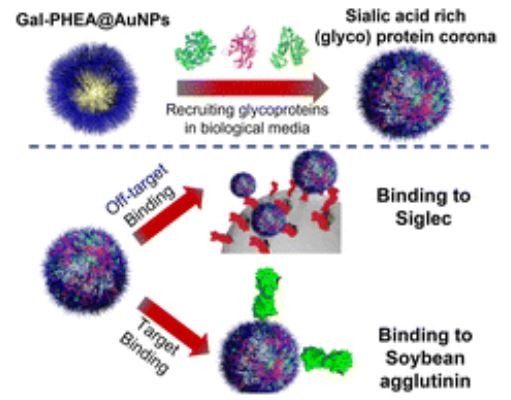Our ESRs Ashfaq Ahmad and Panagiotis G. Georgiou, from the Gibson group at the University of Warwick have co-authored a paper published in RSC Nanoscale, on the biomolecular corona of glycosylated gold nanoparticles, in collaboration with ESR Alessia Pancaro from VITO.
Upon exposure to biological fluids, the fouling of nanomaterial surfaces results in the non-specific capture of proteins, which is particularly important when in contact with blood for in vivo and ex vivo applications. It is crucial to evaluate not just the protein components, but also the glycans attached to those proteins. Polymer-tethered glycosylated gold nanoparticles have shown promise for use in biosensing/diagnostics, but the impact of the glycoprotein corona has not been established.
Here we investigate how polymer-tethered glycosylated gold nanoparticles retain binding affinity towards target lectins post-corona formation. However, the protein corona also introduces additional glycans (mainly sialic acids) on the surface of nanoparticles, and hence, off-target binding towards sialic acid binding lectins, such as human-relevant glycan binding immune receptor SIGLEC-2, was also observed.
These results demonstrated the importance of the glycans when considering the protein corona and how ‘retention of the desired function’ does not rule out the “installation of undesired function” when considering the performance of glyco-nanomaterials.
Reference:
Ashfaq Ahmad, Panagiotis G. Georgiou, Alessia Pancaro, Muhammad Hasan, Inge Nelissen, and Matthew I. Gibson. Polymer-tethered glycosylated gold nanoparticles recruit sialylated glycoproteins into their protein corona, leading to off-target lectin binding. NanoScale. 2022. Open Access.
